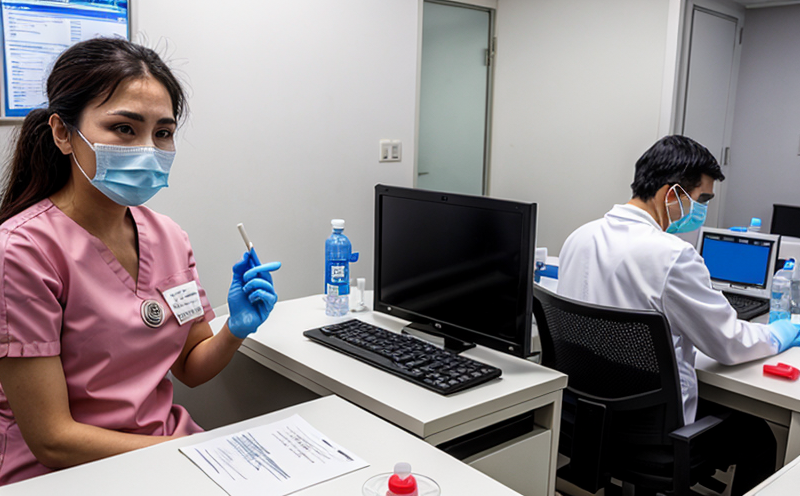Enterovirus Detection Testing in Recreational Waters
In recent years, recreational water bodies have increasingly become focal points for public health concerns. Enteroviruses, a family of viruses that includes polioviruses, coxsackieviruses, echoviruses, and enteroviruses, can be transmitted through contaminated water sources. The detection and monitoring of these pathogens in recreational waters are critical to prevent outbreaks and ensure the safety of swimmers and bathers.
The primary goal of Enterovirus Detection Testing is to identify the presence of these viruses in recreational waters such as swimming pools, lakes, and beaches. This testing involves several steps, including water sampling, specimen preparation, nucleic acid extraction, and viral amplification using advanced molecular techniques like RT-qPCR (Reverse Transcription Quantitative Polymerase Chain Reaction).
Recreational water bodies are not only popular destinations for leisure but also potential vectors for the transmission of enteroviruses. These viruses can persist in aquatic environments, especially under favorable conditions such as high temperature and pH levels. Therefore, regular monitoring is essential to maintain public health standards.
The testing process begins with the collection of water samples from various locations within a body of water. Once collected, these samples undergo rigorous preparation steps to ensure optimal conditions for viral detection. This includes filtering the water to concentrate potential virus particles and then preserving them in suitable buffers before further processing.
Nucleic acid extraction is a crucial step where RNA or DNA from enteroviruses is isolated from the sample matrix. This process ensures that the genetic material of the virus remains intact for subsequent amplification steps. Following successful extraction, the nucleic acids are subjected to reverse transcription if necessary, converting viral RNA into complementary DNA strands which can then be amplified.
The amplification step typically employs real-time quantitative PCR technology due to its high sensitivity and specificity in detecting minute quantities of viral genetic material. During this phase, primers specific to enterovirus sequences are used to target and multiply the viral nucleic acids exponentially. Fluorescent markers incorporated into these probes allow for real-time monitoring of the amplification process, enabling precise quantification of viral loads present.
After completing all necessary analytical steps, results are interpreted based on established cut-off values defined by relevant regulatory bodies such as WHO (World Health Organization) or CDC (Centers for Disease Control and Prevention). These organizations set guidelines regarding acceptable levels of enteroviruses in recreational waters to protect public health effectively.
Regular monitoring programs play a vital role in maintaining water quality standards and preventing potential outbreaks. By implementing routine Enterovirus Detection Testing, authorities can take timely corrective actions if high viral concentrations are detected. Such measures might include increased chlorine treatment or closing certain areas temporarily until contamination levels drop below acceptable thresholds.
It is important to note that while this testing method focuses primarily on enteroviruses, it also provides valuable insights into overall water quality by identifying other pathogens present in the sample matrix. This comprehensive approach enhances our understanding of aquatic ecosystems and supports evidence-based decision-making processes related to public health.
Industry Applications
Healthcare facilities monitoring for infection control measures
Pool operators ensuring compliance with regulatory standards
Government agencies responsible for water quality management
Research institutions studying pathogen behavior in aquatic environments
Water treatment plants assessing effectiveness of disinfection processes
Environmental consulting firms providing expert advice on water safety issues
The application of Enterovirus Detection Testing extends beyond mere compliance checks; it plays a crucial role in safeguarding public health by identifying potential risks early. Through continuous monitoring, stakeholders can implement appropriate mitigation strategies to minimize the spread of enteroviruses and other pathogens.
Eurolab Advantages
At Eurolab, we specialize in providing high-quality Enterovirus Detection Testing services tailored specifically for recreational waters. Our expertise lies in delivering accurate, reliable results using state-of-the-art technologies and methodologies aligned with international standards such as ISO 15189.
Accurate and precise detection of enteroviruses
Comprehensive quality assurance protocols ensuring consistent performance
Experienced technical staff equipped with specialized knowledge in virology and serology testing
Fast turnaround times without compromising on accuracy or reliability
We pride ourselves on offering personalized solutions that meet the unique needs of each client. Whether you're a healthcare facility looking to enhance infection control practices or an environmental agency aiming to protect public health, Eurolab is committed to delivering exceptional service every time.
Quality and Reliability Assurance
At Eurolab, we adhere strictly to stringent quality assurance procedures to ensure the highest standards of reliability in our Enterovirus Detection Testing services. These protocols are designed to minimize errors and maintain consistent accuracy throughout every stage of the testing process.
Robust calibration practices ensuring precise measurement instruments
Stringent quality control measures implemented at all levels from sample collection to final reporting
Regular internal audits conducted by trained personnel guarantee adherence to best practices and continuous improvement
Compliance with international standards including ISO 15189, WHO guidelines, and CDC protocols
Our commitment to quality extends beyond just following established norms; it involves constant innovation and adaptation to new challenges faced by the industry. By staying ahead of emerging trends and incorporating cutting-edge technologies into our operations, we strive to maintain our position as leaders in this field.





